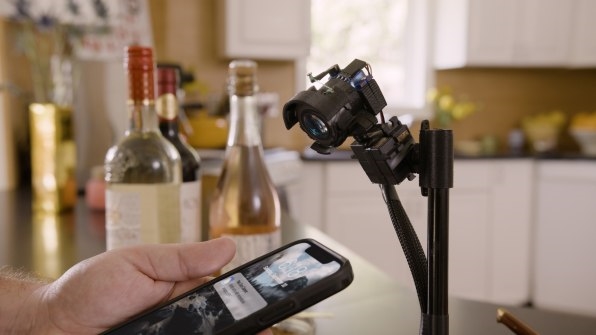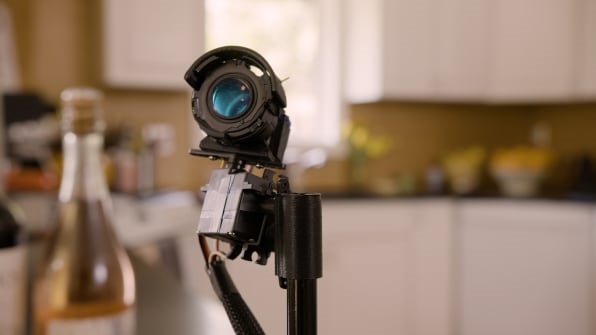Wink is an adorable robot assistant that captures what Google, Apple, and Amazon forgot
He’s just so freakin’ cute.
Wink sits in a corner or on a table, minding his own business. But glance over at the lamp-sized robot and it springs to life, looking up at you with all the anticipation of a loyal dog. “Wink, could you turn on that light?” you ask, pointing to a nearby lamp. Wink turns its head to face the light, blinks once like Barbara Eden, and presto, the light is on.
What might first appear as a technological gimmick is actually a considerably designed, working robot concept by Argodesign. While Apple, Google, and Amazon have learned to understand our speech and converse through our queries via all sorts of smart speakers, these conversations still feel slow and stilted. They’re not as satisfying or simple as they should be. Wink highlights just how much communicative nuance we’ve lost in the rise of voice assistants.

Often, the amorphous voice of god that is Siri or Alexa will repeat what we said and what they are doing next simply to confirm that they are doing it right—just the sort of task that a glance or a nod would handle in real life human-to-human communication. “Everything we react to in life has some form of face, and that coincides with [our] willingness to engage with it,” says Mark Rolston, founder of Argodesign. “I’m not willing to engage in any conversation with a thing without directionality. I’m not sure where to direct my energies.”
However, simply adding a typical face to a robot doesn’t necessarily make it something you want to interact with, either. Case in point. “Giving it two eyes and a face…doesn’t seem to work,” says Guus Baggermans, Principal Designer at Argodesign. “Because when you [actually] work with a robot, the way they drive and move makes you feel they are approachable, safe, and friendly.”
Baggermans developed the industrial design of Wink with a minimal amount of anthropomorphism or even polish, and instead defined its approachability through animation. A single eye—with that blinking eyelid inspired by the 1986 film Short Circuit’s robot protagonist Johnny Five (though you can see Pixar’s Luxo Jr. and Apex Legends’ Pathfinder if you squint)—is all we get in terms of a face. Wink looks like a dead selfie stick in Baggerman’s hands as we talk over video chat. But when Wink awakens with a person’s glance, its posture invites conversation.

With this comfort comes plenty of practical benefits. For one, Wink doesn’t listen for a trigger word like “Siri,” and never begins eavesdropping until it makes eye contact. (Yes, the privacy trade-off here is that rather than a microphone, a camera is analyzing you all the time—though Argodesign has all of these systems running locally on Wink, so your personal data doesn’t go to the cloud.) Second, Wink doesn’t just see you; it can also see objects, triangulating your gaze to know the object that you might be talking about. That means you can ask Wink to send information to a phone you hold up in your hand, or turn on/off a specific light in your house simply by looking the light’s way.

“It can complete the instructions where you’d otherwise have to say ‘turn off the southern lights in the kitchen,’” says Rolston. “It’s a ridiculous command.”
Rolston calls this sort of onerous conversation “the Star Trek problem,” as Gene Roddenberry’s sci-fi world imagined crew members speaking in highly focused sentences to an amorphous Computer (sans body language). Rolston’s comparison is apt. Star Trek very much served as a model for the voice assistance we have today, as it inspired Jeff Bezos to invest in Alexa, along with waves of important human-computer interaction research tracing all the way back in Xerox PARC in the ’80s.
Through animation, Wink doesn’t need lights that glow red or green, or other mechanical abstractions of human behavior, to demonstrate it’s listening or not. Wink doesn’t need to speak to confirm it heard you properly. It just needs to blink, look, and nod. Admittedly, those gestures might be off putting in the hands of an Amazon, which hasn’t demonstrated the best track record of user privacy with Alexa or Ring. But imagine it in the hands of a more altruistic, and auditable, organization.
Wink may seem fantastical, but it is a buildable product: note that Argodesign is currently working on a fully humanoid robot with Apptronik, in a project funded by NASA. But while Argodesign has developed the working prototype, it would need external interest and investment to bring it to market. The firm believes it could operate on the Matter smart home platform, and it’s also mocked up how Wink would look with actual fit and finish (almost like a thermos or automatic pepper grinder, rather than an animated selfie stick). But if nothing else, Wink is a reminder of what we’ve lost in the era of human-sounding voice assistants: namely, the humanity.
(9)



